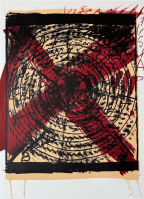
Details
Artist
Styles
Polychrome lithography; E.A from the edition of 110 signed and numbered copies; - Paper: Vélin de Rives; - Plate size: 33 x 50 cm. Artwork size: 63 x 90 cm. - In perfect condition - Published by Erker-Presse, Saint-Gall - Cataloging number: 773. Listed on page 70 of Tàpies. graphic work .1979-1986. Erker-Verlag, 2002. // Suite 63 x 90 by Antoni Tàpies, created in 1980, is a polychrome lithograph printed on Vélin de Rives paper, part of a limited edition of 110 signed and numbered copies. This artwork juxtaposes a bold, black brushstroke that forms an arch-like shape over a background of printed text, resembling a page from a newspaper or directory. The dark brushwork contrasts sharply with the structured lines of text, creating an interplay between abstraction and language. The sweeping, expressive strokes appear almost calligraphic, imbuing the piece with a sense of movement and spontaneity. Published by Erker-Presse in Saint-Gall, Suite 63 x 90 exemplifies Tàpies' exploration of combining raw, gestural marks with printed materials, encouraging viewers to reflect on the relationship between art and the written word.
Suite 63 x 90, 1980
form
Medium
Size
63 x 90 cm
- Inches
- Centimeters
Edition
Price
- USD
- EUR
- GBP
Details
Artist
Styles
Polychrome lithography; E.A from the edition of 110 signed and numbered copies; - Paper: Vélin de Rives; - Plate size: 33 x 50 cm. Artwork size: 63 x 90 cm. - In perfect condition - Published by Erker-Presse, Saint-Gall - Cataloging number: 773. Listed on page 70 of Tàpies. graphic work .1979-1986. Erker-Verlag, 2002. // Suite 63 x 90 by Antoni Tàpies, created in 1980, is a polychrome lithograph printed on Vélin de Rives paper, part of a limited edition of 110 signed and numbered copies. This artwork juxtaposes a bold, black brushstroke that forms an arch-like shape over a background of printed text, resembling a page from a newspaper or directory. The dark brushwork contrasts sharply with the structured lines of text, creating an interplay between abstraction and language. The sweeping, expressive strokes appear almost calligraphic, imbuing the piece with a sense of movement and spontaneity. Published by Erker-Presse in Saint-Gall, Suite 63 x 90 exemplifies Tàpies' exploration of combining raw, gestural marks with printed materials, encouraging viewers to reflect on the relationship between art and the written word.
- Recently Added
- Price (low-high )
- Price (high-low )
- Year (low-high )
- Year (high-low )
Antoni Tapies
Primer Congreso Nacional De Neuropedriatria, 1982
Limited Edition Print
Etching
EUR 1,875
What is automatism?
Automatism refers to a technique in the creative process that accesses material from the unconscious or subconscious mind. It is based on Sigmund Freud’s psychoanalytic method of free association. Artists value this process for its ability to inspire creative thought and spontaneous creation.

























































































































